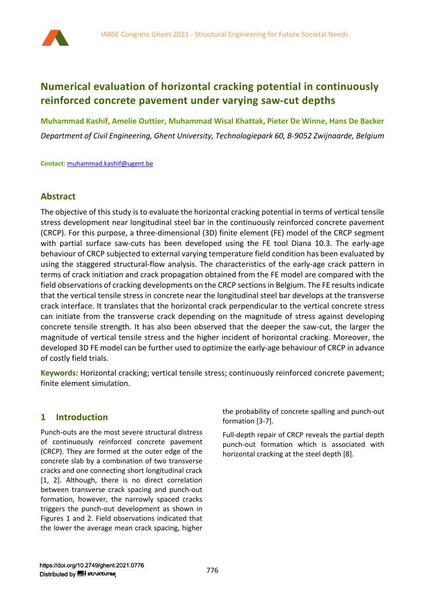Numerical evaluation of horizontal cracking potential in continuously reinforced concrete pavement under varying saw-cut depths

|
|
|||||||||||
Bibliographic Details
| Author(s): |
Muhammad Kashif
(Department of Civil Engineering, Ghent University, Technologiepark 60, B-9052 Zwijnaarde, Belgium)
Amelie Outtier (Department of Civil Engineering, Ghent University, Technologiepark 60, B-9052 Zwijnaarde, Belgium) Muhammad Wisal Khattak (Department of Civil Engineering, Ghent University, Technologiepark 60, B-9052 Zwijnaarde, Belgium) Pieter De Winne (Department of Civil Engineering, Ghent University, Technologiepark 60, B-9052 Zwijnaarde, Belgium) Hans De Backer |
||||
|---|---|---|---|---|---|
| Medium: | conference paper | ||||
| Language(s): | English | ||||
| Conference: | IABSE Congress: Structural Engineering for Future Societal Needs, Ghent, Belgium, 22-24 September 2021 | ||||
| Published in: | IABSE Congress Ghent 2021 | ||||
|
|||||
| Page(s): | 776-782 | ||||
| Total no. of pages: | 7 | ||||
| DOI: | 10.2749/ghent.2021.0776 | ||||
| Abstract: |
The objective of this study is to evaluate the horizontal cracking potential in terms of vertical tensile stress development near longitudinal steel bar in the continuously reinforced concrete pavement (CRCP). For this purpose, a three-dimensional (3D) finite element (FE) model of the CRCP segment with partial surface saw-cuts has been developed using the FE tool Diana 10.3. The early-age behaviour of CRCP subjected to external varying temperature field condition has been evaluated by using the staggered structural-flow analysis. The characteristics of the early-age crack pattern in terms of crack initiation and crack propagation obtained from the FE model are compared with the field observations of cracking developments on the CRCP sections in Belgium. The FE results indicate that the vertical tensile stress in concrete near the longitudinal steel bar develops at the transverse crack interface. It translates that the horizontal crack perpendicular to the vertical concrete stress can initiate from the transverse crack depending on the magnitude of stress against developing concrete tensile strength. It has also been observed that the deeper the saw-cut, the larger the magnitude of vertical tensile stress and the higher incident of horizontal cracking. Moreover, the developed 3D FE model can be further used to optimize the early-age behaviour of CRCP in advance of costly field trials. |
||||
| Keywords: |
finite element simulation Horizontal cracking vertical tensile stress continuously reinforced concrete pavement
|
||||
| Copyright: | © 2021 International Association for Bridge and Structural Engineering (IABSE) | ||||
| License: | This creative work is copyrighted material and may not be used without explicit approval by the author and/or copyright owner. |
||||
